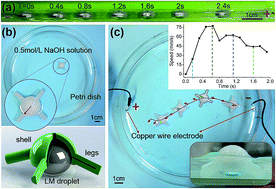Liquid metal wheeled small vehicle for cargo delivery†
Abstract
Miniaturized-vehicles are witnessing an increasing demand in many areas such as lab-on-chip, flexible fabrication, micro fluidics and small object manipulation. Lots of effort has therefore been made to build a small-scale, controllable, robust and adaptable carrying vehicle. To explore an alternative way, an innovative vehicle driven by liquid metal droplet “wheels” is presented with a geometric size in the millimeter scale. Unlike former trials, this vehicle is a movable structure composed of soft wheels and a rigid body. Such a hybrid construction adapts to multiple electrolytes especially NaOH solution. Under variable conditions of electrical voltages and channels, the present vehicle can be controlled precisely to achieve progression, steering and more complex locomotion. With a boat-like core body, the vehicle can take burdens up to 0.4 gram at a speed of about 25 mm s−1. More sophisticated vehicles with integrated manipulators and power supplies could still be built based on the current attempt. This kind of vehicle design realizes complex and accurate control as well as driving of a miniaturized robotic structure. The present finding may shed light on the construction of further complex miniaturized machines or robots in the future.


 Please wait while we load your content...
Please wait while we load your content...